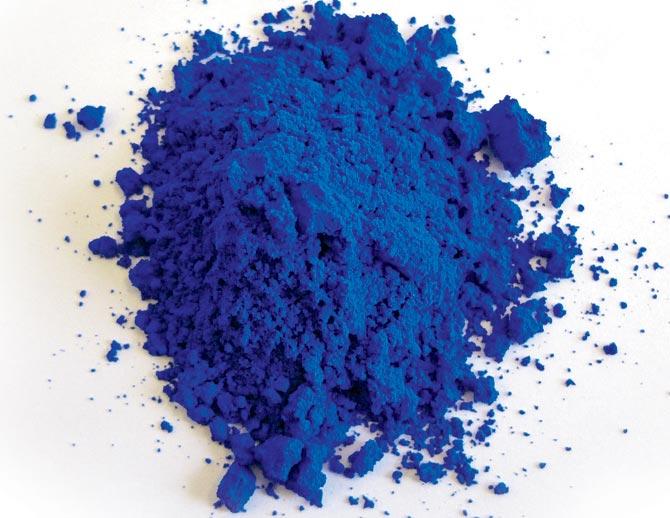Get over cobalt blue. There is a new pigment that the world is waiting for, and it has both tech guys and artists on tenterhooks

Dr Mas Subramanian and his team discovered a new inorganic pigment named YInMn Blue. Pic/Oregon State University
 It is no strange coincidence that the dreamy sky in Vincent van Gogh's The Starry Night uses cobalt blue. The Starry Night was painted about 90 years after Louis Jacques Thénard, a French chemist, discovered this pigment.
It is no strange coincidence that the dreamy sky in Vincent van Gogh's The Starry Night uses cobalt blue. The Starry Night was painted about 90 years after Louis Jacques Thénard, a French chemist, discovered this pigment.
Thénard was asked by his government to improve colours for their artists (trust the French to come up with something like this) and cobalt blue was thus born. We have seen versions of it in our cozy painting-kits through school, but van Gogh took it more seriously. He waxed eloquent in a letter to his brother Theo, stating, "Cobalt [blue] is a divine colour and there is nothing so beautiful for putting atmosphere around things."

Dr Mas Subramanian and his team discovered a new inorganic pigment named YInMn Blue. Pic/Oregon State University
If only van Gogh knew about YInMn Blue. In 2009, more than two centuries after cobalt blue's discovery, chemist Dr Mas Subramanian and his team discovered a new inorganic pigment. Christened after its components — manganese, yttrium and indium — YInMn (pronounced yin-min) Blue is lush and brilliant. After six years of testing and approvals, the pigment will now be made available commercially by The Shepherd Colour Company, based in Ohio, USA, which has its roots in making colours for porcelain enamels.
Unlike Thénard, Subramanian and his team weren't looking for new pigments. The team, based in the Oregon State University (OSU), USA, stumbled upon it while researching materials for electrical conductivity. YInMn Blue is in the league of serendipitous discoveries such as the little blue pill Viagra (originally intended to relax blood vessels by Pfizer), Vaseline (which used to jam up drills in oil fields) and Teflon.

Mount Hood by Aquarelles de Mas Blue (Rajeevi Subramanian). Except white, all pigments used are from the YInMn Blue family
"After we mixed manganese oxide with other chemicals and heated them in a furnace of nearly 2,000 degrees Fahrenheit, we were shocked to see the results. We expected to see a black or brown result, as manganese oxide is black," says Subramanian, over a Skype chat. His team member, graduate student Andrew Smith had initially made the samples to study their electrical properties. When the outcome turned out to be a resplendent blue, "I instantly realised we were looking at something new," says Subramanian, who is the Milton Harris Professor of Materials in the OSU Department of Chemistry.
Subramanian says that this stable inorganic pigment is safe, unlike cobalt blue, which could be carcinogenic, or Prussian blue, which can release cyanide under certain conditions. But, before we venture any further, a little clarification on colours and pigments, courtesy IIT-Madras-bred Subramanian. Pigments are materials and colours are properties (you can make several shades of blue from YInMn, for instance). Inorganic pigments, such as Prussian blue and YInMn Blue, cannot be used on fabrics. Natural dyes like indigo can, however.

After this quick primer, Subramanian says that ever since The Shepherd Colour Company announced production, he has been receiving emails by the dozen, both from technologists and artists alike. Turns out that blue is a hot favourite around the world. "Out of the USA's 50 states, 41 desire blue. It has nothing to do with being a Republican or a Democrat, however," he laughs.
Among tech folk, YInMn Blue, which has been included in the Forbes Pigment Collection at the Harvard Art Museums, is likely to be used for surface and roof coatings in the automobile industry. It is a cool pigment and, born under extremely high temperatures, can stand the heat. "It is a little more expensive than cobalt blue, but since we are looking for energy-saving options, YInMn Blue could be one. Even if you mix a little with white, it can enhance the cooling properties," he says. Imagine Greek villas in Santorini infused with a bit of YInMn Blue in them.
"With the tech side, it is more about durability or usefulness. Artists have a different psychology. For them, it is about what difference YInMn Blue can make to their works," says Subramanian. Art restorers are likely to make note of this new blue as it doesn't fade as easily as the lapis lazuli used in Michelangelo's Last Judgement in the Sistine Chapel or Istanbul's blue monuments.
Over at the OSU, students have been using YInMn Blue in their paintings and even made nail colour out of it. And, Subramanian's spouse, Rajeevi, a chemist and artist, has been painting a series using YInMn Blue. In the meanwhile, the impending popularity for YInMn is only set to grow. We can only wonder if Anish Kapoor, who has got the exclusive rights to use vantablack — the blackest black — has his eyes on this new pigment too.
 Subscribe today by clicking the link and stay updated with the latest news!" Click here!
Subscribe today by clicking the link and stay updated with the latest news!" Click here!









